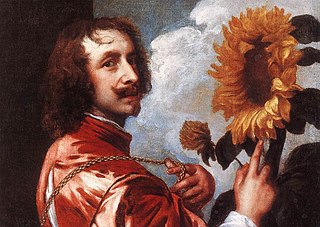
Sir Anthony van Dyck was a Flemish Baroque artist who became the leading court painter in England after success in the Spanish Netherlands and Italy.
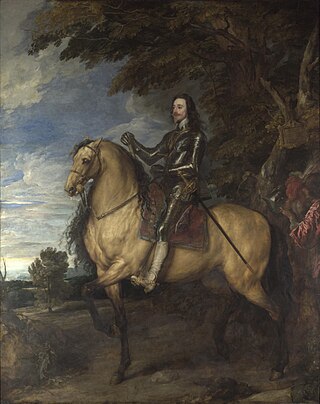
The Equestrian Portrait of Charles I is a large oil painting on canvas by Anthony van Dyck, showing Charles I on horseback. Charles I had become King of England, Scotland and Ireland in 1625 on the death of his father James I, and Van Dyck became Charles's Principal Painter in Ordinary in 1632.
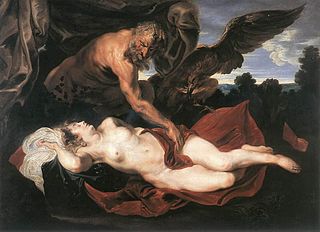
Jupiter and Antiope is a series of two similar oil-on-canvas paintings by the late Baroque Flemish painter Anthony van Dyck. One painting is in the collection of the Museum of Fine Arts, Ghent; the other in the Wallraf-Richartz Museum, Cologne.

Charles I at the Hunt – also known under its French title, Le Roi à la chasse – is an oil-on-canvas portrait of Charles I of England by Anthony van Dyck c. 1635, now in the Louvre Museum, Paris. It depicts Charles in civilian clothing and standing next to a horse as if resting on a hunt, in a manner described by the Louvre as a "subtle compromise between gentlemanly nonchalance and regal assurance".

The Portrait of Olivia Porter is an oil painting on canvas by Anthony van Dyck, showing Olivia, Lady Porter, the wife of Sir Endymion Porter, daughter of John Boteler, 1st Baron Boteler of Bramfield, and niece of the Duke of Buckingham, a zealous Roman Catholic and a lady in waiting to Henrietta Maria of France, queen consort to Charles I of England. It was discovered on the Your Paintings website by Bendor Grosvenor after being documented by the Public Catalogue Foundation.

Saint Ambrose barring Theodosius from Milan Cathedral is a painting of c. 1619–20 by Anthony van Dyck in the National Gallery, London.

Magistrate of Brussels is an unfinished oil painting or oil sketch by Anthony van Dyck, rediscovered in 2013 after being shown on episodes of the BBC television programme Antiques Roadshow.
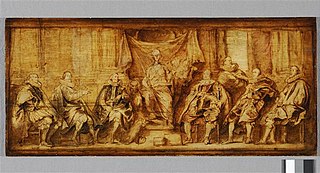
Magistrates of Brussels was a 1634-35 oil painting by Anthony van Dyck. It was destroyed in the French bombardment of Brussels in 1695. Its composition is known from a grisaille sketch in the École nationale supérieure des Beaux-Arts in Paris, which Van Dyck prepared to show how he planned to lay out the work.

Samson and Delilah is a 1620 painting by Anthony van Dyck.It was heavily inspired by his tutor Rubens's version of the same subject and for a long time was attributed to Rubens. Van Dyck inverted the composition and showed Delilah in white chalk make-up and heavily rouged cheeks, the makeup traditionally worn by Parisian prostitutes. The painting is now held in the Dulwich Picture Gallery in London. He returned to the subject in 1630.

Samson and Delilah is a 1630 painting by Anthony van Dyck. Like his 1620 version of the subject, it is in the style of his former master Peter Paul Rubens. Unlike Rubens, however, van Dyck shows Delilah seemingly appalled at her own betrayal of Samson and regretting her act of treason, whereas Rubens showed him as a captive and her as an unscrupulous temptress. Van Dyck's palette in the work also reveals the influence of Titian during van Dyck's stay in Italy. It is now in the Kunsthistorisches Museum in Vienna.

Cupid and Psyche is an oil on canvas painting by Anthony van Dyck. It is now in the Royal Collection and shown in Kensington Palace.

Madonna and Child is a 1621–1627 painting by Anthony van Dyck, now in the Galleria nazionale di Parma.

Madonna and Child with Two Donors or The Madonna of the Two Donors is a 1630 painting by Anthony van Dyck, now in the Louvre, in Paris.

St Martin Dividing his Cloak is a painting by the Flemish painter Anthony van Dyck dated around 1618, which is an altarpiece in the Sint-Martinuskerk in Zaventem, Belgium. The painting portrays the story of Saint Martin sharing his cloak with a beggar. This early work of van Dyck was painted when he was strongly influenced by Rubens's style.
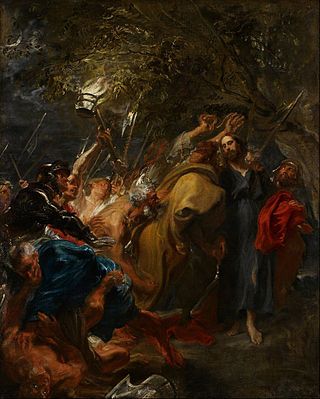
The Betrayal of Christ is a 1620 painting by Anthony van Dyck, now in the Minneapolis Institute of Arts. He also produced two other versions of the same subject at around the same time, now in Bristol and Madrid.

The Self-portrait is an oil on canvas painting by the Flemish artist Anthony van Dyck. It is held at the Metropolitan Museum of Art, in New York. The work depicts its creator during his early twenties.

Saint Rosalia Crowned by Angels is an oil on canvas painting by the studio of Anthony van Dyck, created c. 1624, one of several works showing the saint produced whilst van Dyck was quarantined in Palermo, Sicily due to a plague. It is now in the Galleria Regionale del Palazzo Abatellis in Palermo, where in 2015 it was displayed alongside Saint Rosalie Interceding, loaned from the Metropolitan Museum of Art.

Saint Rosalia Crowned by Angels is a c. 1625 oil on canvas painting by Anthony van Dyck, one of five surviving works showing the saint which he produced whilst he was quarantined in Palermo, Sicily due to a plague. It is now in the Menil Collection in Houston, Texas, which bought it in 1968. It was loaned from there in 2011-2012 to the Dulwich Picture Gallery in London.

Saint Rosalia is a c.1625 oil on canvas painting by Anthony van Dyck. Originally owned by Giovan Francesco Serra di Cassano, it was bought by Philip IV of Spain via his Viceroy of Naples Gaspar de Bracamonte in 1664 and is now in the Museo del Prado in Madrid

Saint Rosalia Interceding for the City of Palermo is an oil on canvas painting of Saint Rosalia by Anthony van Dyck, now in the Museo de Arte de Ponce in Puerto Rico, which acquired it at auction at Sotheby's in London on 7 December 1960. It is sometimes dated to 1629 when the artist was back in Antwerp and sometimes to 1624-1625 whilst the artist was quarantined in Palermo, Sicily.




















